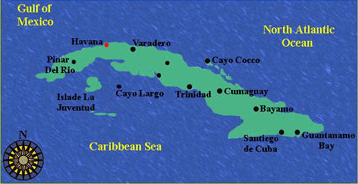Cuba
In 1526, after a horrifying cross-Atlantic journey, the first African slaves arrived in Cuba. By the end of the 18th century, Cuba had become a slave plantation society with a mixed culture of African and European descent. By the late 1800s, there were over 370,000 slaves from Africa or of African descent in Cuba and 80% of those slaves worked on sugar cane plantations. Although work in the plantations was both difficult and demoralizing for slaves and workers, music on the island was incredibly vibrant.
Rumba is an original black form of drumming, singing, and dance that often addressed social preoccupations. Rumba spread from the plantations to the slums and quickly became a form of shared collective expression. The Cuban rumba is an example of polyrhythm and uses 3-based and 2-based rhythms at the same time. For example, the lead drummer drummer might play in 6/8, while the rest of the ensemble keeps playing in 2/2.
Danzón is a more sophisticated ballroom dance musical form developed in the 19th Century, and serves as a foundation for much contemporary Cuban music. The danzón was originally considered a “scandalous” dance because it was practiced by all levels and classes of society! A newspaper in 1888 is even quoted as saying "We recommend banning the danza and danzón because they are vestiges of Africa and should be replaced by essentially European dances such as the quadrille and rigadoon."
Modern Salsa music and dancing has its roots in the son, a style which originated in eastern Cuba. It has been said that the son embodies the essences of Cuba and it is the most influential and widespread forms of all Latin American music. Its most characteristic instruments are the Cuban guitar known, as the tres, and the double-headed bongó.
Another popular style in the 1920s was Afrocubanismo. Afrocubanismo created a forum in which Cuba's hybrid African-Hispanic culture and identity could be discussed through music. Afrocubanismo focused on issues of recognition and assimilation, as well as validation, of African heritage in Cuban society. Afrocubanismo challenged the divisive social realities of Cuba and its composers were severely criticized and professionally marginalized. However, they can perhaps feel vindicated knowing that because of Afrocubanism, Cuba became the musical fountain from which Reggae, Samba in Brazil, Latin Salsa, the Blues, Jazz and even Gospel originated.
A major change in Cuban music came following the Cuban Revolution in 1959, when a new group of classical musicians joined the scene. Among these musicians was guitarist Leo Brouwer, who was instrumental in the formation of the "nueva trova" movement. The trova consists of an itinerant troubadour singing ballads. This style of music was transformed into nueva trova, whose lyrics concentrated on issues of socialism, injustice, sexism, colonialism, racism and politics.
Another popular genera is the guaracha. The guaracha consists of both a rapid tempo and lyrics. It originated in Bufo comic theatre in the early-to-mid 19th century. During the early 20th century it became popular in the brothels and houses of ill repute in Havanna. The lyrics of the guaracha often told the stories of events and people in the news and were full of slang and satire.

